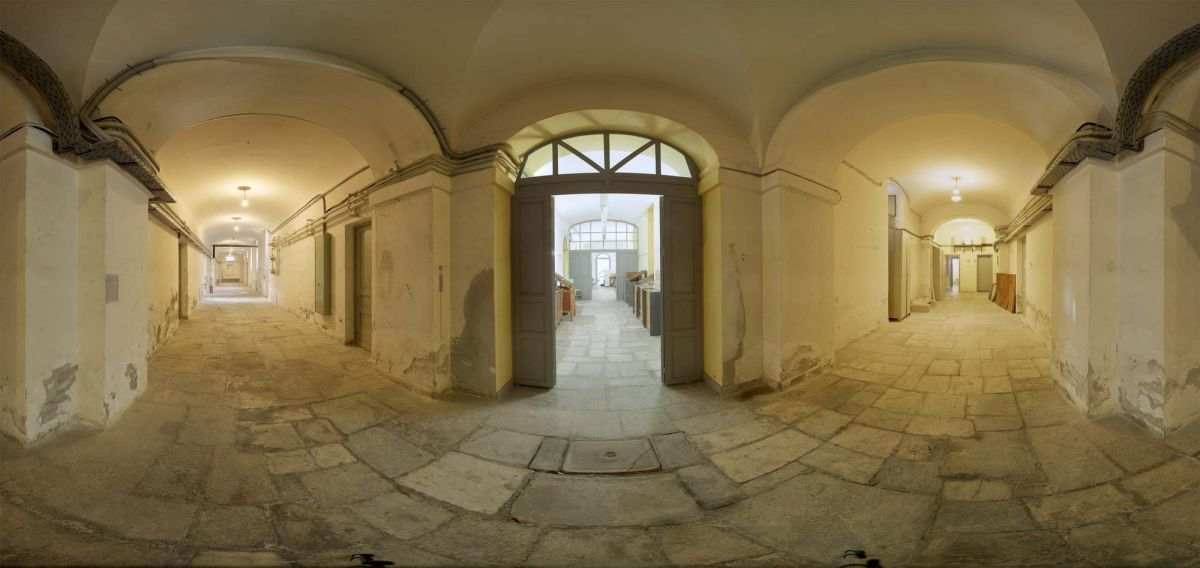TAKIS KOUMPIS / Architect
In a reverse move, photography becomes the other aspect of painting, which always carries along the very thing it depicts. With a series of retardations, sublations and postponements it works out its photographic “canvas”. From the subterranean corridors leading to the studios of the graduate students of the Athens School of Fine Arts (ASFA) to the desolate corridors of the Xenia Hotel on mount Parnes, the multiple takes of Chris Simatos suggest, from the very beginning, the question of the purely material constitution of the image through its multiple self. These photos are not simply taken whenever the “click” defines the conception and the impression, but rather when hundreds of them, superimposed versions of the same frame, like the thousands colored stains of the brush, create the pan-iconic, panoramic take of the entirely fractional, fragmentary image. The one becomes multiple.
The photographic experience as a material construction of images makes photography the ultimate art of retardation. Retardation precedes the snap-shot. In these multiple takes, the images, due to the reduced retardation, appear at the same time both delayed and accelerated. The fragmentation of the corridor of the abandoned Xenia Hotel constitutes a characteristic example, where each image is transferred on the exhibition wall in order to fragment it, turn it into a ruin, since parts of the frayed plaster are superimposed over the plastered void, in an attempt to turn everything into a representation, within the boundaries, however, of a process of sublation. What else could the parallel sighting of the real wall as well as its photographic counterpart signify? Can the boundary of the wall of an exhibition site be turned into an opening, a starting point instead of an end? Openings, transits, corridors, transitions which uplift dead ends, suggesting routes within a space of unfathomable depth, constitute the photographic exploration of the possibility to project everything in front of the viewer, in the sense of a reverse optical correction, which touches on the field of perspective, however not intending to surrender to it, but to disturb it, to cancel it out, to negate as well as preserve it. In the end, this is the double meaning of the Aufhebung, the term Hegel proposed for sublation, as Jacques Derrida interprets it: the double pattern of a convention that “eliminates by preserving”.
The vanishing points not lying on a straight line undermine perspective, disturb its discernibleness. On site, the fragmentary squares, aided by a canvas, take on the task of breaking it, replacing it. This is possible at another point of the site, where the squares are spread like cards on a blank geographical map. One wonders, how many squares constitute a perspective image? The answer remains elusive, since the image is not only one, is not integrate, it has no entirety. The ontology of the canvas of the squares hides leakages, to the point that certain pieces are elusive, absent. The rest, which are exhibited, constitute the punctum, as meant by Roland Barthes, and are therefore the ones recording the event. They are the little holes, the little incisions, the stains of randomness which poke and penetrate the viewer. In contrast, the missing pieces belong to the process of memory, of perception and constitute the studium, the general study and attachment to our subject.
However, why does the artist propose this specific site dominated by the theme of the desolate Xenia Hotel? The architecture of the 1960’s Xenia Hotels was the unexpected event of the choice of another place that eluded collective consciousness. Their design created, with unique clarity and purity, open-closed places, semi open-air ones, as well as new spatial structures, introducing systemically the exteriority into the heart of the building. These places of heterotopy and ascetic esthetics had initially engraved the worst degree of entropy on their bodies, since they knew how to turn themselves into an excellent ruin, that continues to stir up deep feelings with the loss of its utilitarian purpose. The Mount Parnes Xenia, which served primarily as a sanatorium, belongs to “the divergent heterotopies”, as Michel Foucault calls them, which expect from the one photographing them to show the temporalities of their desolation, extinction, death. The site, through an, almost discrete, sequence of interior takes of the Xenia, sets the expediting of the long-ought death of the building in contrast to retardation of the photographic act. Photography can delay death, however not prevent it.
Consequently, the almost archeological in style, cold depictions of the corridors, staircases and rooms of the Xenia are exhibited to the viewers sight, implying the “unfamiliar familiarity” of the hospitable sanatorium. On the other hand, the viewer, in a counter-clockwise motion, faces the underground corridor of the ASFA as the corresponding familiar space, which, when duplicated, resembles the interior of the Xenia, in another timeline, preceeding its demise, under the warm illumination of its actual usage. These unsimilar similarities allow the construction of new spatial recompositions, which, on the one hand, exhaust the temporal record of the condemned to perish ruin, and on the other hand, expand the light-spatial exploration towards the new constructions of an interior architecture, causing a peculiar feeling of protecting the images’ aura.
If artists today are “condemned to seek for the beauty of the Non-Places”, as Marc Augé claims, or accept the positive presence of the unfamiliar, as Maurice Blanchot would prefer, this particular photographic site attempts an infiltration, a motion of our glance transcending the complexing, disjunctive or contrasting bipole, familiar and unfamiliar, familiar or unfamiliar, or familiar versus familiar.


